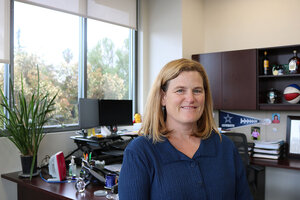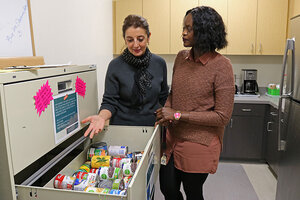In L.A., resources grow for homeless community college students
Innovative ideas – from food pantries on campus to the first homeless shelter for college students – are on the rise in Los Angeles. Those involved with higher ed say they have a moral duty to meet the basic needs of learners so they can succeed.

Los Angeles Valley College President Erika Endrijonas knows many students at her school struggle with homelessness, but she says individual schools can only do so much to help without state-funded housing.
Story Hinckley/The Christian Science Monitor
Los Angeles and Santa Monica, Calif.
After living in her truck for three months with her teenage daughter and dog Snoopy, Alix Silverman decided it was time to go to college.
She had always worked minimum wage jobs to make rent, but she found herself homeless after getting injured on the job. So when the city of Los Angeles approved her for Section 8 housing, Ms. Silverman, who has a GED, knew she had to take advantage of her new federally subsidized rent and enrolled in the community college down the street.
“I always wanted to go to college but I never had money for anything else [besides rent]...,” says the forty-something Ms. Silverman. “I was like: This is my opportunity.”
Silverman plans to graduate from Los Angeles Valley College (LAVC) next year with an associate’s degree in art history. She hopes to transfer to a four-year college – ideally UCLA – to earn her bachelor’s degree so she can find a job in art history research.
“I’m not even an artist, I just love to work around art and the history of people and cultures,” says Silverman. She looks down at her spiral notebook, and when she looks up, she is crying. “I get emotional, I’m sorry. I just finally found something that I am so interested in and fascinated by.”
Community colleges like LAVC have traditionally been a popular and effective route for lifting Americans like Silverman out of poverty. But the lack of affordable housing across the country is preventing or delaying students from obtaining the degrees and certificates that they need to improve their future.
Among community college students nationwide, two in three students are food insecure (meaning they often go hungry), half are housing insecure (meaning they often can't pay their full rent or utility bills), and almost 14 percent are homeless, according to a 2016 survey by the Wisconsin HOPE Lab in Madison. And in California, the state with the greatest homelessness problem, housing crises among students enrolled in Los Angeles Community College District’s nine colleges are the norm: almost one in five indicated they had experienced homelessness in the past year, based on a 2016 survey.
Community colleges may only get funded to instruct students, but education leaders in Los Angeles say that their moral and ethical duties go beyond the classroom. And while there are no present state or federal plans to fund housing on community college campuses, faculty, staff, and students in and around Los Angeles are piecing together their own solutions.
“It’s not just about getting an ‘A’ or a ‘B,’ ” says Ellie Rabani, director of LAVC’s CalWORKs program and one of the faculty members who first called attention to the problem of homelessness on campus. “If you are hungry, you can't study. If you don't have a place to sleep, you can’t study. If we want them to transfer and become whoever they want, we have to provide these things to them.”
In 2016, 5.9 million Americans were enrolled in public, two-year colleges. Employment projections suggest these students are a smart investment: by 2026, employment opportunities for US workers with an associate or bachelor’s degree will grow by at least 10 percent, whereas growth for workers with a high school diploma is projected to be half of that.
“We hear a lot of press, academics, and politicians talk about how we need a higher skilled workforce,” says Jed Richardson, acting director of the Wisconsin HOPE Lab, which focuses on economic barriers to postsecondary education. “The only way to increase the skill of the workforce is to increase the skills of the exact students we are talking about: nontraditional students who come from low-income families.”
'It was so embarrassing.'
The first office in LAVC’s new administration building is for CalWORKs, the public welfare program for parents. On the outside the office’s glass windows are posters advertising various programs (“Need $ for food? Apply for CalFresh!”) and on the inside are rows of smiling women in cubicles, a basket of apples for visitors to grab on their way out, and a corner of kid toys.
Symbolic of the way that LAVC pushes the bounds of state-funded resources, the CalWORKs office has become something bigger: the epicenter for the Helping Hands Project, which aims to be “a temporary bridge” that allows homeless students to finish their educational plans by providing them with various resources. What began as a group of faculty and staff collecting money for a homeless mother on campus five years ago has become a program that helped 45 students in the last six months, many of them with stories like Silverman's and that of Steven Fuel, who recently found himself homeless with only one semester left of school.
“I didn't want anybody to know because it was so embarrassing. You feel like you have everything you want and then it’s totally taken away from you,” says Mr. Fuel. “But I just thought: I can’t quit. I’m so close.”
Fuel says he only regrets not asking his school for help sooner. Helping Hands didn’t find him housing, but it eased his financial situation in almost every other way so he could save up money and move into a friend’s apartment, and soon thereafter, his own apartment near school.
“I’m not saying we do everything [for students], because housing is a big thing. But we have access to make their lives a little bit easier,” says Ms. Rabani. “Students can say, ‘I deal with my problems at 9:00 pm. But when I come to Valley College, I don’t have a problem. I have food, friends, mentors, and instructors.’ ”
A kitchen intended for CalWORKS and Helping Hands staff has become a makeshift food pantry, with cans of green beans and soup filling filing cabinets. Down the hallway from the office, Helping Hands has taken over a storage room with shelves of toiletries, bed sheets, clothes, shoes, and towels, many of the supplies donated by the school’s faculty and staff.
To help with transportation costs to and from campus, Helping Hands offers monthly gas reimbursements of $60 or half-off bus cards. Students can borrow textbooks from Helping Hands free of charge, and return them at the end of the semester for other students to use. Free tutoring is offered in a classroom attached to the CalWorks office. Every morning, school staff picks up leftover breakfast food from the nearby elementary school and every Sunday they pick up leftover produce from the nearby Studio City farmers’ market.
Even though Silverman has housing, she says these resources have been crucial to making sure she stays enrolled full time at LAVC. It is hard to financially recover from a stint of homelessness, she explains, and her family often runs short on grocery money.
“I don’t think there is that line where we say, ‘Okay, we don’t help with that,’ because the alternative will be that we won’t have students,” says Emily Mutanda, who was hired in July to lead Helping Hands.
Fuel is on track to graduate with a certificate in broadcasting this spring and he hopes to have his own radio show someday.
“It never came to my mind that my school could help me in the ways that Helping Hands has helped me,” he says. “Without their help the last couple of months, I would not have made it through.”
A student-run shelter
Across the city from LAVC, the Students4Students shelter has a unique approach to tackling student homelessness in nearby Santa Monica.
The first of its kind in the country, the Students4Students shelter is run by college students, for college students. The shelter itself was also the idea of a student, UCLA engineering graduate student Louis Tse, after he noticed students sleeping on campus.
Students4Students, formerly called the Bruin Shelter, is funded entirely by crowdfunding. Opened at the beginning of the 2016-2017 school year in the back room of a nearby Lutheran church, it has eight beds and offers students six months of free housing and a family-style breakfast and dinner every day.
“It was a completely humbling revelation,” Rebecca Sarvady, a UCLA senior who volunteers at the shelter, says about learning so many of her peers had housing troubles. "We spend so much time as students worrying about classes, clubs, and maybe tuition, but the concept of being housing insecure feels like a whole different ballpark."
Perhaps the most encouraging component of the shelter is the large team who runs it. Ms. Sarvady and 72 of her UCLA peers manage everything from preparing dinners from the group’s laminated binder of recipes, to advertising the facility and supervising the shelter at night. The UCLA volunteers sign confidentiality agreements and students who interview the shelter applicants go through social work training.
Any college student is welcome to apply, but as the two college pennants in the shelter’s hangout room suggest, the majority of the 23 students that the shelter helped last year were enrolled in either Santa Monica College (SMC), a community college, or UCLA.
At SMC, student homelessness is so prevalent that faculty and staff sometimes offer to house students themselves, says Nancy Grass, associate dean of student life, who currently has a homeless student living with her.
“The Students4Students shelter has been a fantastic idea. We are so grateful they have offered us beds. But we are dealing with hundreds [of homeless students], so having four beds...,” Dr. Grass says, trailing off. “It’s a great step forward, but it’s a little one.”
Looking ahead
In the fall of 2016, California Gov. Jerry Brown approved two laws to help struggling college students: community colleges must allow shower times for homeless students as well as improve food access by expanding CalFresh (or foodstamp) benefits on campus and allocating funding to on-campus food pantries.
California has also tried to keep tuition low. A full-time community college student in California will pay roughly $1,450 per school year, less than half the national average.
But until the state puts serious funding specifically towards housing, or relaxes zoning laws for building on state-funded campuses, say educators, the situation can only improve so much. Community college enrollment is dropping across the state, says LAVC President Erika Endrijonas, and the high cost of living for students is definitely a factor.
In the meantime, LAVC will continue to look for creative solutions to help students. Helping Hands plans to build a pantry-cafe on campus to replace the filing cabinet system, and Endrijonas is working with a team of University of Southern California architects and local nonprofits to research the possibility of building small moveable apartment pods.
“We know it’s a problem, we are doing everything we can, and whenever there is a roadblock, we try to address it,” says Dr. Endrijonas. “But in the end, they fund me to instruct people, not to help them [with housing]... and that’s where the rub is.”


